Famous Love Paintings – The Most Romantic Paintings in History
Despite the many tragedies of history that have inspired artists to pick up their paint brushes, love has remained a recurring subject for many centuries. From mythology to human desires, love has been portrayed in countless ways throughout the ages. Below, we will explore a selection of some of the world’s most famous love paintings that are embedded with symbols and messages of all things romance! Keep reading for more about these popular love paintings!
Contents
- 1 Portraying Love in Art
- 2 Exploring the Top 15 Most Famous Love Paintings
- 2.1 Madonna and Child (c. 1450 – 1465) by Filippo Lippi
- 2.2 Venus and Adonis (c. 1550s) by Titian
- 2.3 The Honeysuckle Bower (c. 1609) by Peter Paul Rubens
- 2.4 The Jewish Bride (1665 – 1669) by Rembrandt van Rijn
- 2.5 Les Hasards Heureux de L’Escarpolette (1767) by Jean-Honoré Fragonard
- 2.6 The Lock (1777) by Jean-Honoré Fragonard
- 2.7 The Kiss (1859) by Francesco Hayez
- 2.8 The Cradle (1872) by Berthe Morisot
- 2.9 Chez le Père Lathuille (1879) by Édouard Manet
- 2.10 L’Amour et Psyché (1890) by William-Adolphe Bouguereau
- 2.11 The Kiss (1907 – 1908) by Gustav Klimt
- 2.12 Birthday (1915) by Marc Chagall
- 2.13 The Embrace (1917) by Egon Schiele
- 2.14 The Lovers (1928) by René Magritte
- 2.15 Self-Portrait as a Tehuana (c. 1940 – 1943) by Frida Kahlo
- 3 Frequently Asked Questions
Portraying Love in Art
Love is generally understood as a verb and emotion that invites one to ponder over the ones dearest to our hearts. In art history, art about love has been portrayed in a variety of ways and encoded with various social symbols that represent elements of love. Through color, symbols, and direct representations of expressions related to love. These include themes of romance, eroticism, desire, jealousy, and companionship, expressed through narrative artwork inspired by mythology, history, and everyday life.
The most famous expression of love is physical touch displayed through a warm embrace, a dramatic kiss, or a gentle gaze.
From portraits to allegorical paintings, artists have drawn from their own unique experiences and stories of others about love and created some of the most endearing works of art. It is a subject that one cannot ignore and is only human to explore. Below, we will take a closer look at some of the most renowned love paintings in art history that have shaped our understanding of centuries’ worth of expressions of love and the way it is represented in art.
Exploring the Top 15 Most Famous Love Paintings
The depiction of love in art history is a universal theme that spans many periods and cultures across the world. From ancient paintings to Renaissance sculptures, love has been portrayed in all its nuances, including platonic, divine, romantic, and familial. Love is one such emotion that has the power to capture the depth of human relationships and has been depicted in art history through religious symbols, personal expressions, and allegorical tales that resonate with many. Below, we will dive into the top 15 most famous love paintings in art history that have defined the genre of love painting itself!
Madonna and Child (c. 1450 – 1465) by Filippo Lippi
| Artist Name | Filippo Lippi O.Carm. (1406 – 1469) |
| Date | c. 1450 – 1465 |
| Medium | Tempera on panel |
| Dimensions (cm) | 92 × 63.5 |
| Where It Is Housed | Uffizi Gallery, Florence, Italy |
This famous Italian Renaissance painting, Madonna and Child, was created by Filippo Lippi between 1450 and 1465 and represents the close bond between the religious figures Mary and the infant Jesus. The iconic depiction of the Madonna with Child went on to influence many painters of the Renaissance and is recognized as the Madonna of the Uffizi Gallery, where it is housed today. Lippi’s patrons were the Medicis who once claimed that he did not adhere to his contracts.
Madonna and Child was a commissioned piece intended as a gift for the King of Naples in 1457 and was a remarkable demonstration of Lippi’s use of the fresco technique, which was popular in Florence at the time.

The love embedded in the painting also possesses a deeper meaning, alluding to the love and connection created between the marriage of one’s soul and God. Today, the Madonna and Child remains one of the most iconic artworks about love.
Venus and Adonis (c. 1550s) by Titian
| Artist Name | Tiziano Vecelli (Titian) (1488 – 1576) |
| Date | c. 1550s |
| Medium | Oil on canvas |
| Dimensions (cm) | 106.7 x 133.4 |
| Where It Is Housed | The Metropolitan Museum of Art, New York City, United States |
Venus and Adonis are among the most famous 16th-century love paintings, created by the master painter Titian around the 1550s. 16th-century art about love was derived from ancient Greek and Roman mythology and folklore, and can be seen in many Renaissance artworks about love. The painting depicts a scene inspired by Greek mythology and the stories from Ovid’s Metamorphoses, which moved Titian to invent his own poetry through painting.
The narrative illustrates Venus, the goddess of love, attempting to stop her lover from leaving for the hunt and is a moment of vulnerability expressed through fear, love, and concern.

The illustration of Venus, known as Aphrodite in Greek culture, was focused on evoking sensuality and heightening the tragedy that followed. The expressions in their eyes also show a frightened Cupid, who was perhaps aware of his fate. The emotional intensity of the artwork made it one of the Venetian artist’s best works and is a symbol of desire, mortality, and love.
The Honeysuckle Bower (c. 1609) by Peter Paul Rubens
| Artist Name | Sir Peter Paul Rubens (1577 – 1640) |
| Date | c. 1609 |
| Medium | Oil on canvas |
| Dimensions (cm) | 178 x 136.5 |
| Where It Is Housed | Alte Pinakothek, Munich, Germany |
This famous full-length body portrait of a loving couple was painted by Sir Peter Paul Rubens around 1609. One may not expect to see the artist himself as the young man in the painting, depicted alongside his wife Isabella Brant, who is seated below a vine of honeysuckle in a garden composition. Rubens highlighted the importance of his love for his wife and their union by creating a self-portrait in a traditional marriage composition.
The two are dressed in luxurious clothing and are seen holding each other’s right hands. The Honeysuckle Bower was initially a gift for Brant’s father, but later ended up in the collection of the Duke, Johann Wilhem II.
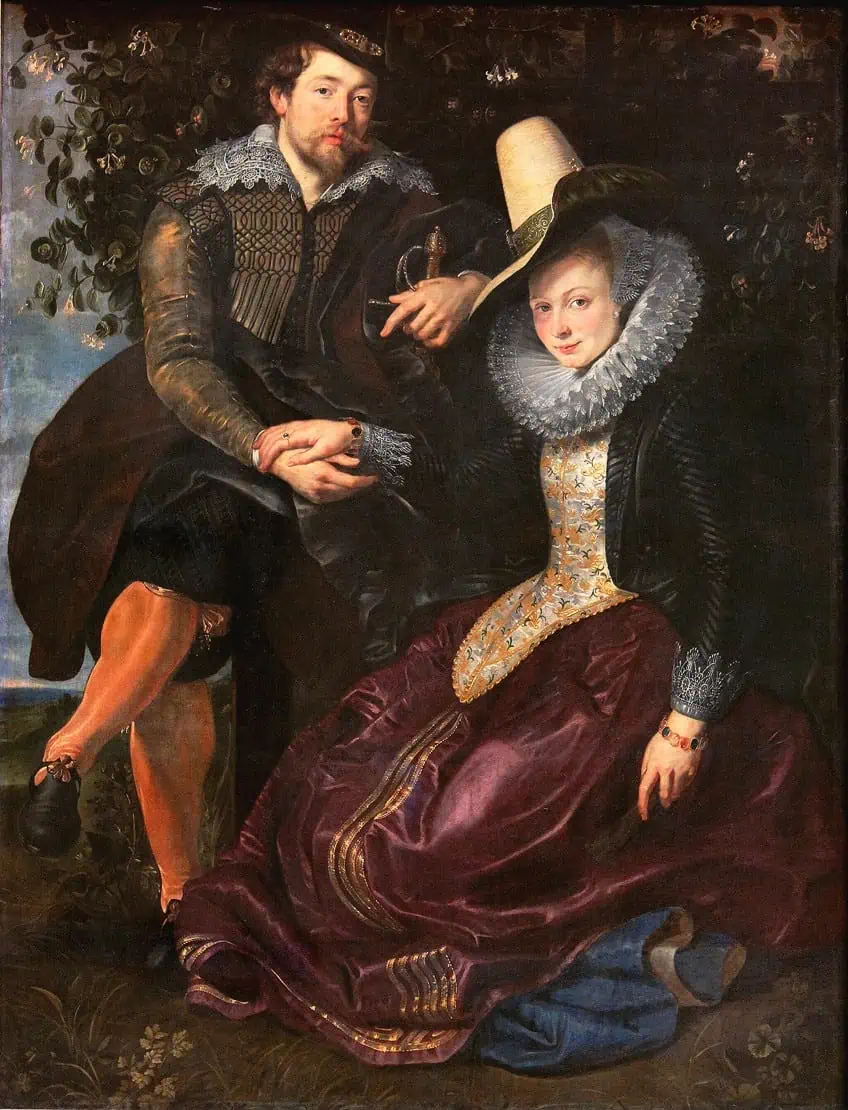
Together, Rubens and his wife had three children and were married for 17 years until Isabella died in 1625. One of the most interesting aspects of the painting is the symbolism of the honeysuckle plant, which was derived from the Middle Ages as a symbol of lasting pleasure and permanence. Another popular love concept of the Renaissance was the Garden of Love, which originated as a symbol of paradise and the role of the garden in aristocracy. Regarding Rubens’ portrayal of himself, he carefully included a sword to remind viewers of his status as a member of the elite class, who was also a court painter. The work is not only one of the best examples of love painting in the 17th century but also an example of self-fashioning on Rubens’ part.
The Jewish Bride (1665 – 1669) by Rembrandt van Rijn
| Artist Name | Rembrandt van Rijn (1606 – 1669) |
| Date | 1665 – 1669 |
| Medium | Oil on canvas |
| Dimensions (cm) | 121.5 x 166.5 |
| Where It Is Housed | Rijksmuseum, Amsterdam, the Netherlands |
Created by Renaissance master painter Rembrandt, The Jewish Bride is one of the most famous love paintings in art history, which continues to fascinate art historians. The painting was created between 1665 and 1669 and is one of the best portrayals of love illustrated by a tender moment between the biblical couple Isaac and Rebecca, presented as the Jewish bride and groom.
The newlyweds were executed in a brilliant chiaroscuro effect, which heightens the emotional impact of the moment.
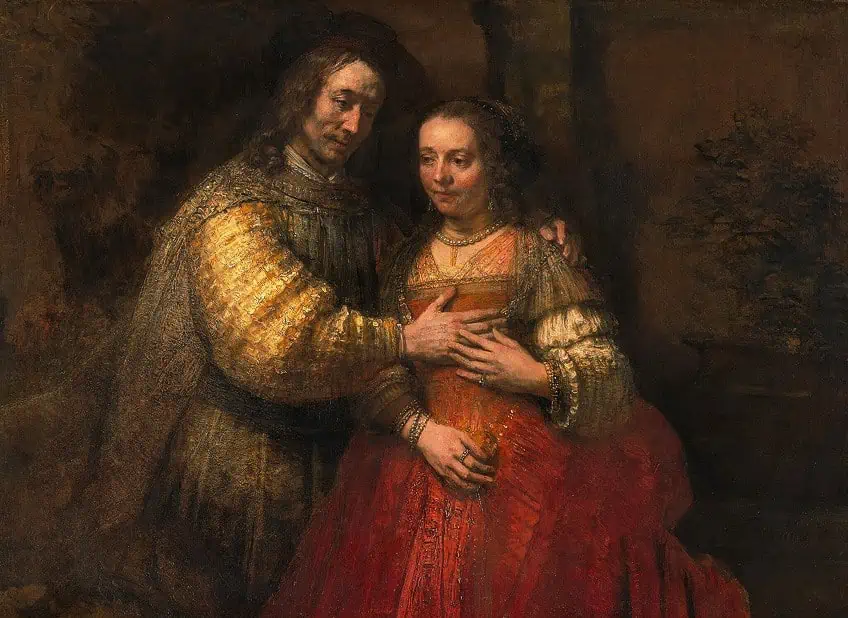
The intimate moment shared by the couple is a universal symbol of their devotion to one another and love’s purity. The couple also exchange loving gazes and the scene is elevated with Rembrandt’s use of warm color that envelops the viewer into the scene. According to scholars, the painting is one of the most tender expressions of physical and spiritual love in the history of art.
Les Hasards Heureux de L’Escarpolette (1767) by Jean-Honoré Fragonard
| Artist Name | Jean-Honoré Fragonard (1732 – 1806) |
| Date | 1767 |
| Medium | Oil on canvas |
| Dimensions (cm) | 81 x 64.2 |
| Where It Is Housed | The Wallace Collection, London, United Kingdom |
This famous love painting Les Hasards Heureux de L’Escarpolette is also recognized as The Swing and was created by Jean-Honoré Fragonard in 1767. While the playful composition might simply appear to be quirky and lighthearted fun, the true meaning of the painting holds great significance as a famous love painting and depiction of eroticism. The painting depicts a young woman playfully swinging in the forest while her suitor pushes her from behind. Her shoe is also seen flung in the air as she swishes through the air and another man is seen at the bottom of her swing gazing up at her skirt while donning a mischievous smile.
The painting encompasses the pursuit of love, portrayed by the art of seduction and flirtation in a moment of illicit love as one is led to believe that the painting alludes to the notion of a secret affair.
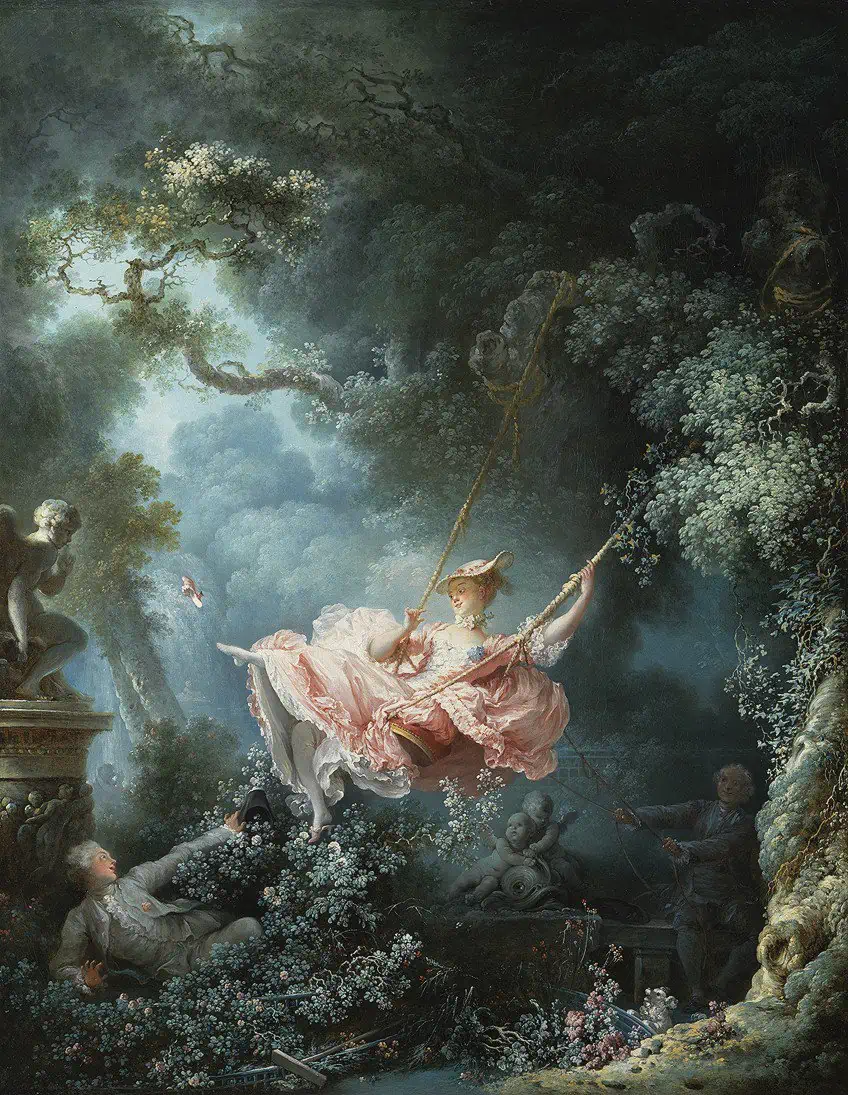
The swing is also symbolic of the fleeting nature of love in 18th-century French society, which is still relatable to many today. Fragonard was intentional with his use of vibrant color and intricate details to captivate the viewer and cast a scene that attracts one to the allure of love through charm, sensuality, and a risqué moment.
The Lock (1777) by Jean-Honoré Fragonard
| Artist Name | Jean-Honoré Fragonard (1732 – 1806) |
| Date | 1777 |
| Medium | Oil on canvas |
| Dimensions (cm) | 73 x 93 |
| Where It Is Housed | Louvre Museum, Paris, France |
This iconic love painting was also created by Jean-Honoré Fragonard in 1777 and is recognized as one of the most famous love paintings in art history. Also known as The Bolt, the famous scene portrays two lovers entwined in a romantic embrace as the man attempts to lock the door.
Housed at the Louvre Museum, The Lock became a symbol of the 18th-century libertine spirit adopted by many artists at the time and was among the most popular themes found in Rococo painting.
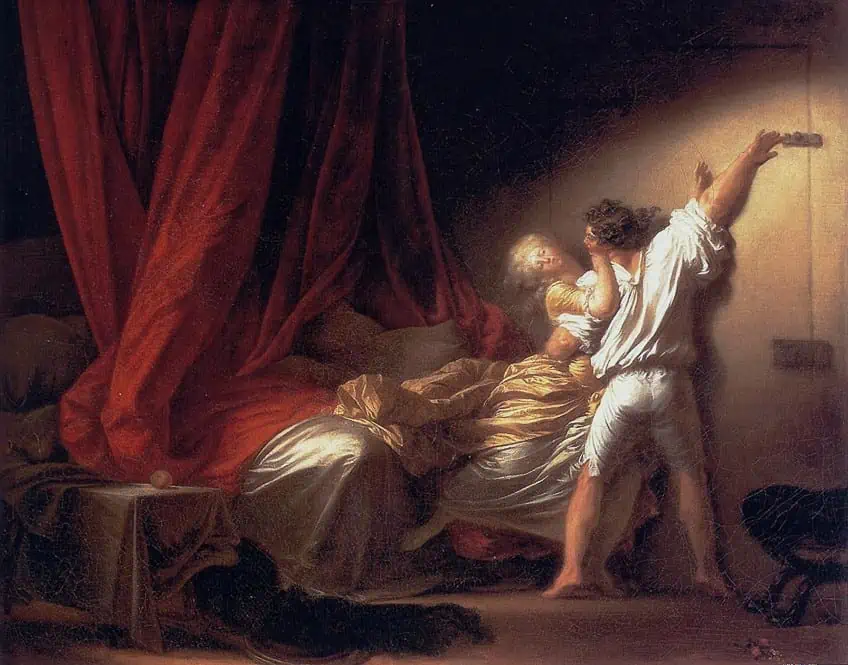
The painting was commissioned by the Marquis de Véri, Louis-Gabriel Véri-Raionard in 1773, who was also a reputable collector. The work was recognized as an erotic artwork that embodied the culture of gallantry in French society. Fragonard also created a twin painting called The Contract, which followed another known as The Armoire, which narrated the story of a passionate couple who were discovered engaging in an affair and later reconciled.
The Kiss (1859) by Francesco Hayez
| Artist Name | Francesco Hayez (1791 – 1882) |
| Date | 1859 |
| Medium | Oil on canvas |
| Dimensions (cm) | 110 × 88 |
| Where It Is Housed | Pinacoteca di Brera, Milan, Italy |
The Kiss was among the most famous paintings from Italian Romanticism that were created by Francesco Hayez around 1859. The painting is said to embody the spirit of Risorgimento, also understood as the unification of Italy, and was commissioned by Alfonso Maria Visconti di Saliceto. The Kiss is not only one of the most famous love paintings of all time but is also a symbol of the Kingdom of Italy, which was a result of the victory against Austrian armies that contributed to the unification process.
The commissioned piece was created with the instruction of Saliceto, who wished to represent the hopes of the alliance between the Kingdom of Sardinia and France.
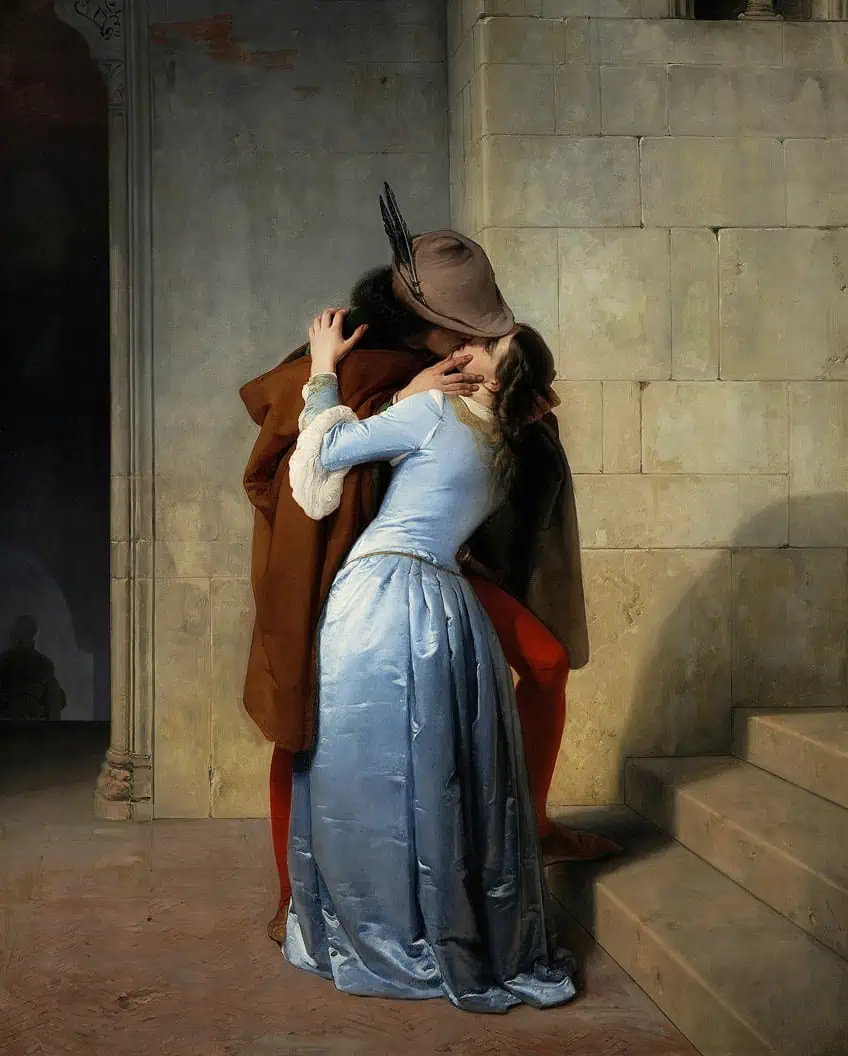
Hayez went on to produce two other versions of The Kiss with variations in the color of the woman’s dress. The Kiss by Francesco Hayez portrays a passionate kiss shared between a man and woman from the Middle Ages and has become the most passionate representation of a kiss in art history. The kiss itself was the focus of the painting since Hayez kept the couple’s faces hidden and evoked the essence of Romanticism by possibly representing a young soldier kissing his lover goodbye as he leaves to fight against the Austro-Hungarian Empire. The image became so popular that it was later featured on the famous chocolate Baci and was also used in the film Senso (1954), directed by Luchino Visconti.
The Cradle (1872) by Berthe Morisot
| Artist Name | Berthe Marie Pauline Morisot (1841 – 1895) |
| Date | 1872 |
| Medium | Oil on canvas |
| Dimensions (cm) | 460 x 560 |
| Where It Is Housed | Musée d’Orsay, Paris, France |
One may instantly recognize the work of Berth Morisot from her intimate paintings that highlight the relationships between mothers and their children. The Cradle is a famous love painting from the 19th century that showcases Edma, Morisot’s sister, watching intently and protectively over her daughter Blanche and is one of the first scenes of early motherhood in Morisot’s career. The clever techniques used by Morisot to highlight their relationship include the sway of the curtain, Edma’s bent left arm, and the mirrored art of her baby, who appears sound asleep and cozy in her cradle.
The theme of intimacy is further elevated by the net of the cradle’s curtain and reminds the viewer of the protective love demonstrated by a mother for the safety of her child.
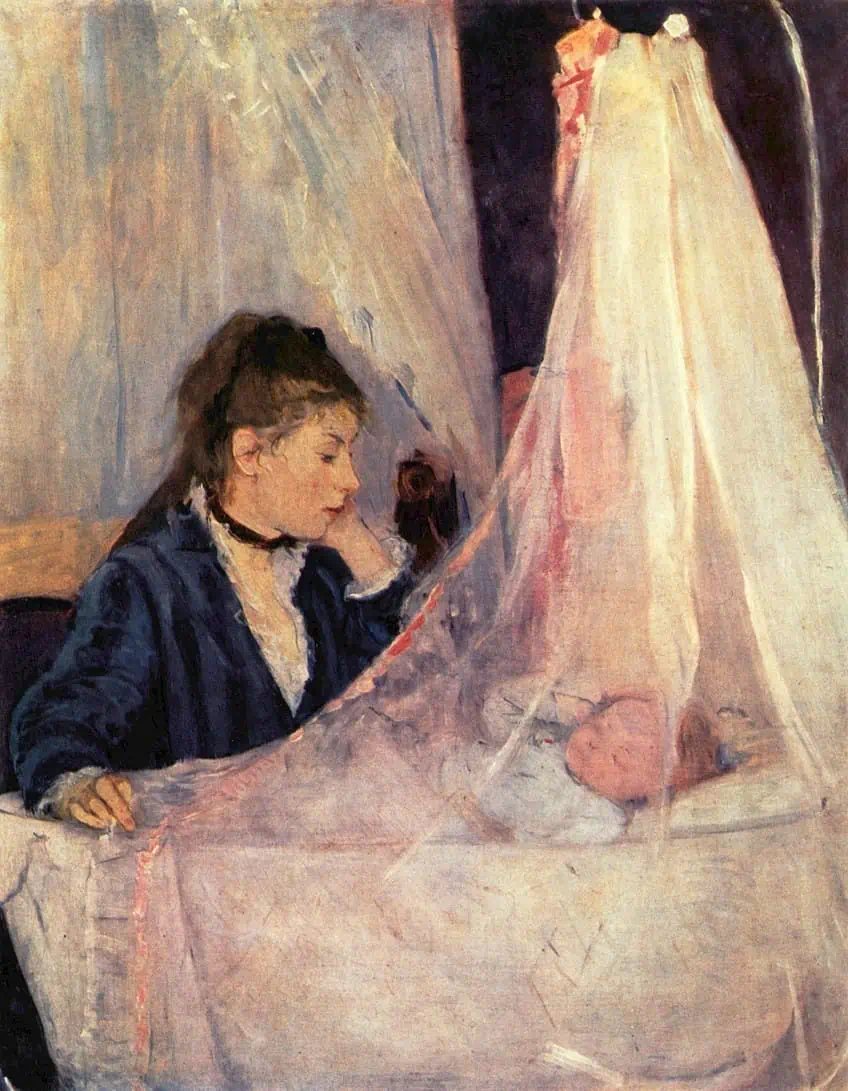
Berthe Morisot was the first female artist to exhibit her work among the Impressionists in 1874, however, her work received praise later on for its elegance and gentle depiction of motherhood. Initially, Morisot also struggled to sell the painting but it was later purchased by the Louvre in 1930 and moved to the Musée d’Orsay, where it is currently housed.
Chez le Père Lathuille (1879) by Édouard Manet
| Artist Name | Édouard Manet (1832 – 1883) |
| Date | 1879 |
| Medium | Oil on canvas |
| Dimensions (cm) | 92 x 112 |
| Where It Is Housed | Musée des beaux-arts de Tournai, Tournai, Belgium |
Édouard Manet was among the most famous French painters who often depicted various 19th-century scenes of love, including Chez le Père Lathuille, which was painted in 1879. The painting embodies the themes of love and romantic interest in Parisian society depicted by a gentleman and woman engaged in conversation at a table.
While it is unclear if the two are already a couple, it is assumed that the two demonstrate romantic interest in one another as indicated by the man’s attentive gaze of admiration and affection.
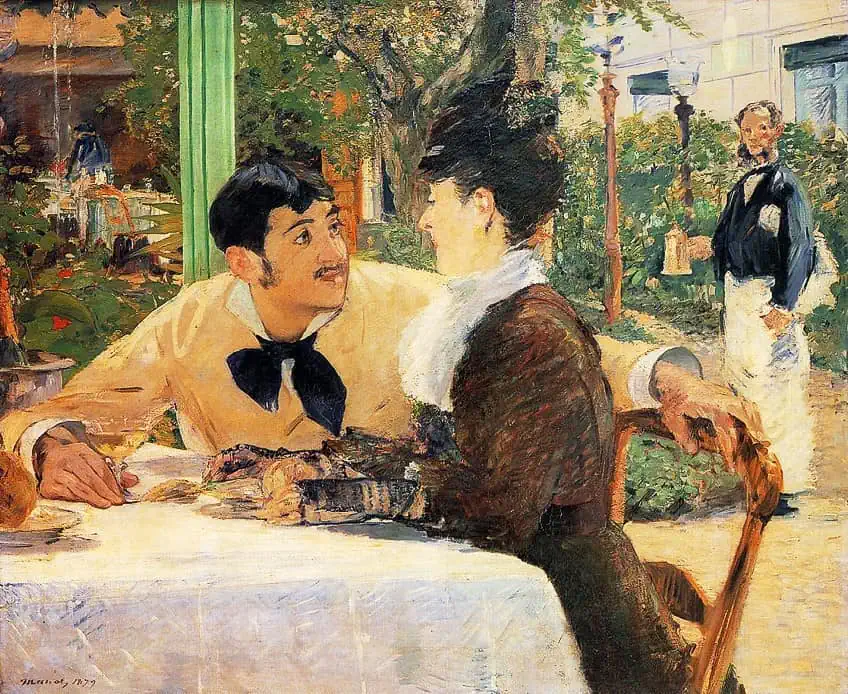
The elegant scene is also filled with intimate details that contribute to the themes of desire and love and can be seen in the placement of the couple at the forefront and the rest of the diners who seem unaware of the romantic exchange. Manet skillfully used warm colors to enhance the intimacy of the scene and build a strong allure to the budding romance. Chez le Père Lathuille also represents the social arrangements of the time, where restaurants were popular sites for people to engage in clandestine meetings. Café culture was the perfect setting for meeting people and is a Contemporary method that Manet used to convey the beauty of everyday encounters and their potential for human connection.
L’Amour et Psyché (1890) by William-Adolphe Bouguereau
| Artist Name | William-Adolphe Bouguereau (1825 – 1905) |
| Date | 1890 |
| Medium | Oil on canvas |
| Dimensions (cm) | 60 × 71 |
| Where It Is Housed | Private collection |
The dainty angelic painting by William-Adolphe Bouguereau is one of the most famous paintings of mythical love embodied by the narrative of the forbidden romance between Cupid and Psyche. The painting depicts the two young children painted in Bouguereau’s signature Neoclassical style in a lighthearted and loving manner. Cupid was painted as an infant while Psyche was portrayed as a young girl with butterfly wings. The reference to the butterfly wings was inspired by Aristotle’s use of the word psyche for butterfly in Greek and was a playful addition to the painting.
The love evoked in the composition highlights the innocent love shared between two young children, which was well-received upon its exhibition at the Salon. At the time, many artists took an interest in Classical Greek art and were drawn to such narratives from Greek mythology.
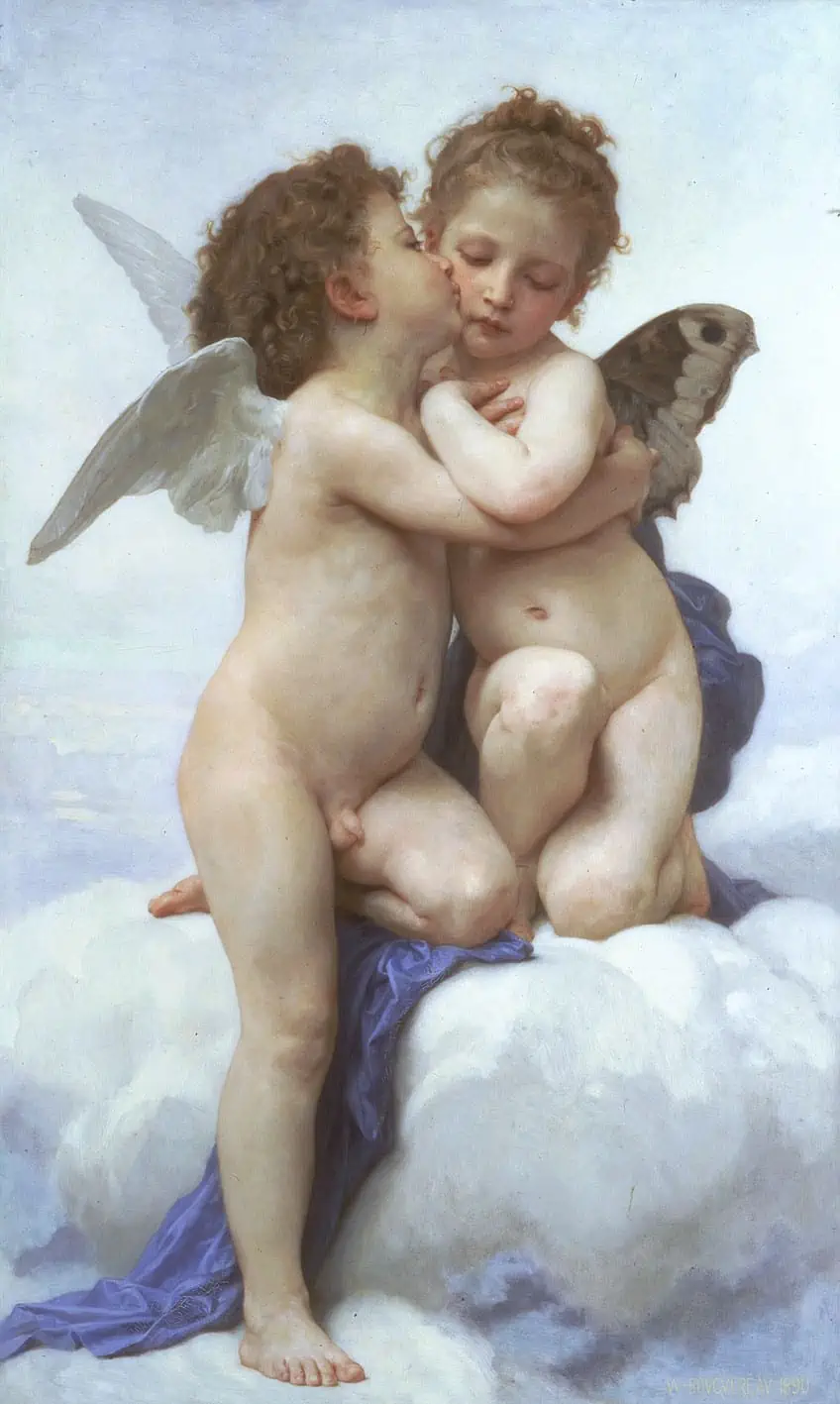
The story of Cupid and Psyche follows the tale of revenge by Aphrodite, who was Cupid’s mother, and who forced Cupid to prick Psyche with his arrow and fall in love with a hideous beast. Venus was jealous of Psyche’s beauty, however, Cupid scratched himself instead and married Psyche in secret on the agreement that she would never see his face. Psyche eventually caved into her curiosity and Cupid fled, causing Psyche to roam the underworld in search of her lover. In the end, the two are reunited and Psyche is granted immortality. What made this story so popular was its theme of overcoming the obstacles of love and difference despite divine forces. Ultimately, true love prevails!
The Kiss (1907 – 1908) by Gustav Klimt
| Artist Name | Gustav Klimt (1826 – 1918) |
| Date | 1907 – 1908 |
| Medium | Oil and gold leaf on canvas |
| Dimensions (cm) | 180 x 180 |
| Where It Is Housed | Österreichische Galerie Belvedere, Vienna, Austria |
The Kiss was also reinterpreted by renowned Art Nouveau and Vienna Secessionist Gustav Klimt, who created this unique and heartwarming painting between 1907 and 1908. The Kiss by Gustav Klimt is among the most well-known love paintings of the 20th century that defined the artist’s “golden period” and was executed in a brilliant array of imaginative shapes and colors, set against a backdrop of gold leaf.
The organic forms and the gentle embrace of the couple in the painting are truly what made this work stand out as a love painting that portrayed romantic intimacy.
The Kiss (1907 – 1908) by Gustav Klimt; Gustav Klimt, Public domain, via Wikimedia Commons
The lovers are portrayed leaning on the edge of a flower patch in a meadow with the man’s body strained downwards toward the woman’s face, where he plants a loving kiss. What makes the composition so endearing is the expression on the woman’s face, which evokes a sense of warmth and compassion since her eyes appear closed in delight at the man’s expression of love and care.
Birthday (1915) by Marc Chagall
| Artist Name | Marc Chagall (1887 – 1985) |
| Date | 1915 |
| Medium | Oil on cardboard |
| Dimensions (cm) | 80.6 x 99.7 |
| Where It Is Housed | Museum of Modern Art, New York City, United States |
Birthday by Marc Chagall is among the most fascinating love paintings in art history that showcases a powerful love between a couple. The composition is set in a bright living room and illustrates the couple, Chagall, and his wife, sharing a kiss.
Chagall portrayed himself in an exaggerated floating position, extending himself to give his wife a kiss in a fantasy-like scene.
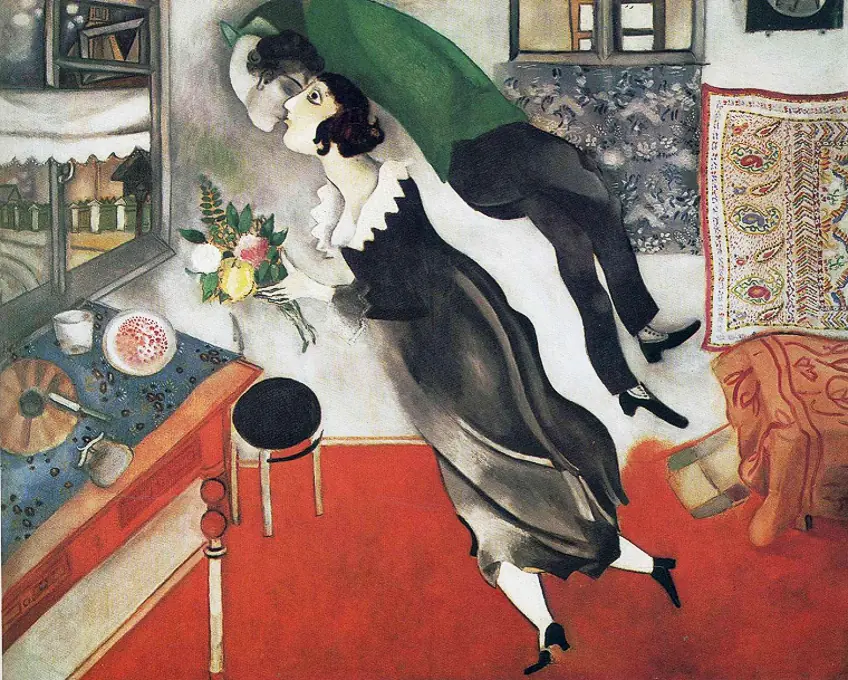
The painting is believed to be a celebration of his wife’s birthday and is a typical representation of provincial Russian interior painting. Chagall met his wife, Bella Rosenfeld, in 1908 and was portrayed holding a bouquet. According to Chagall’s autobiography, he described his encounter with Rosenfeld as a moment of recognition among the two, where he felt that she had already known his past and future. Today, Birthday remains in the permanent collection of the Museum of Modern Art in New York.
The Embrace (1917) by Egon Schiele
| Artist Name | Egon Schiele (1890 – 1918) |
| Date | 1917 |
| Medium | Oil on canvas |
| Dimensions (cm) | 98 x 169 |
| Where It Is Housed | Belvedere, Vienna, Austria |
The Embrace by Egon Schiele is perhaps one of the most popular paintings of love from the Expressionist movement, which was created in 1917, and is an example of genre painting. Egon Schiele’s depiction of love and intimacy was highlighted by his depiction of a nude couple who shared a passionate embrace and were depicted from an aerial view.
The contortion of the figures also evokes a sense of raw emotion and vulnerability of the moment.

Schiele’s use of bold outlines and vivid colors also amplifies the tender intensity of the scene while the figures evoke a sense of melancholy through their intertwined bodies, which suggest a sense of emotional turmoil and entrapment. Such emotions reflect the intensity of love and its many complexities, which can often contradict itself.
The Lovers (1928) by René Magritte
| Artist Name | René François Ghislain Magritte (1898 – 1967) |
| Date | 1928 |
| Medium | Oil on canvas |
| Dimensions (cm) | 54 x 73.4 |
| Where It Is Housed | Museum of Modern Art, New York City, United States |
The Lovers by René Magritte is one of the most famous paintings about love that showcases Magritte’s unique approach to Surrealism and its fascinating relationship with symbolism. The painting was created in 1928 and portrays a couple embracing one another. Their faces appear concealed by white cloth, which is wrapped tightly against their faces.
What makes this painting so significant in the genre of love painting is that it challenges traditional ideas of identity and intimacy within romantic relationships.
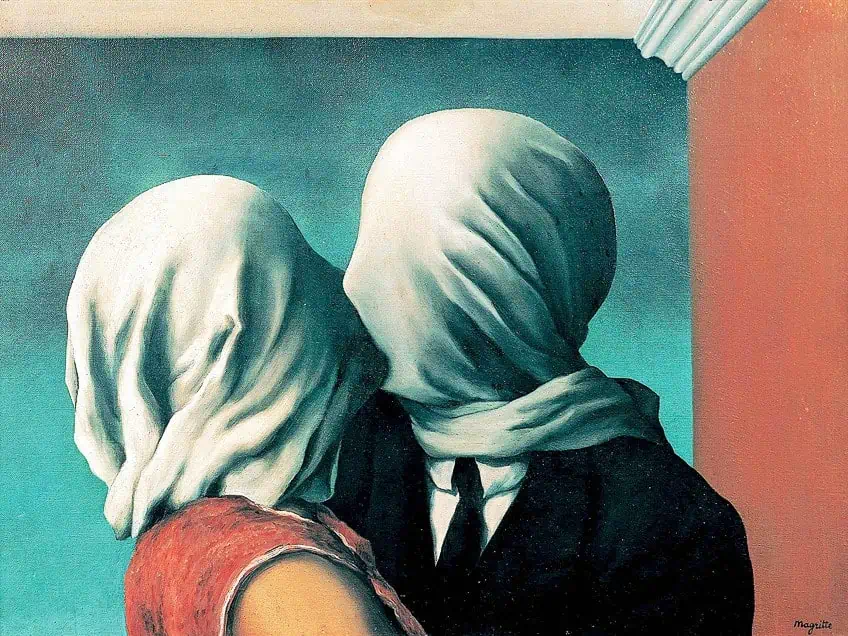
The Lovers also transcends the importance of physical appearance in love and leaves viewers intrigued with the wholesome idea of true love, driven by an emotional connection. The couple is also cast against a dream-like atmosphere, which was Magritte’s signature style in Surrealist painting and has since become an iconic representation of love, curiosity, and the depths of affection that become the basis of most intimate relationships.
Self-Portrait as a Tehuana (c. 1940 – 1943) by Frida Kahlo
| Artist Name | Magdalena Carmen Frida Kahlo y Calderón (1907 – 1954) |
| Date | c. 1940 – 1943 |
| Medium | Oil on masonite |
| Dimensions (cm) | 76 x 61 |
| Where It Is Housed | Art Gallery of New South Wales, Sydney, Australia |
Self-Portrait as a Tehuana is also recognized as Diego on my mind and was one of the most well-known paintings of love and loss created by Frida Kahlo between 1940 and 1943. Frida Kahlo began working on the painting when she and Diego Rivera had just divorced in 1940 and only completed the artwork in 1943.
The painting is a symbol of Kahlo’s desire to possess her ex-husband and long-term lover Diego, which she portrayed in a self-portrait with a mini portrait of Rivera on her third eye.
The painting is perhaps one of the most famous examples of obsessive love in art history and illustrates Kahlo in a traditional Mexican Tehuana dress with a crown that resembles a spider’s web at the base. Another element that heightens the emotional impact of the painting is Kahlo’s eyes, which convey a pained expression at her awareness of her tumultuous emotions, which reflected her undying devotion to Rivera and the complicated history of their relationship. Their relationship was also marked by a lengthy period of suffering and love, which made Self-Portrait as a Tehuana one of the best autobiographical paintings of Kahlo’s experience of intense love.
Love is a multifaceted theme that can be explored in a multitude of ways, as seen in these famous love paintings. We hope that these iconic paintings about love have inspired you to ponder over the complexities of the emotion that offer a rich source of healing, excitement, and emotional depth that no other genre ever could.
Take a look at our love paintings webstory here!
Frequently Asked Questions
What Symbols Were Used to Represent Love in Paintings?
The most common symbol used to represent love in paintings is the rose, which is seen as a universal symbol of passion and love. The rose is recognized as the queen of all flowers, while a red rose represents physical desire. Hearts are another popular symbol of love in art, including apples, the Claddagh symbol, doves, the image of Cupid, the jasmine flower, a harp, maple leaves, and the Celtic love knot.
Which Famous Painters Explored Love in Art?
Many famous painters explored the theme of love in their art. These include artists such as Gustav Klimt, Frida Kahlo, Jean-Honoré Fragonard, and Peter Paul Rubens.
What Are the Three Most Famous Love Paintings?
Among the three most famous paintings about love include artworks such as The Honeysuckle Bower (c. 1609) by Peter Paul Rubens, The Jewish Bride (1665 – 1669) by Rembrandt van Rijn, and The Kiss (1907 – 1908) by Gustav Klimt.
Jordan Anthony is a Cape Town-based film photographer, curator, and arts writer. She holds a Bachelor of Art in Fine Arts from the University of the Witwatersrand, Johannesburg, where she explored themes like healing, identity, dreams, and intuitive creation in her Contemporary art practice. Jordan has collaborated with various local art institutions, including the KZNSA Gallery in Durban, the Turbine Art Fair, and the Wits Art Museum. Her photography focuses on abstract color manipulations, portraiture, candid shots, and urban landscapes. She’s intrigued by philosophy, memory, and esotericism, drawing inspiration from Surrealism, Fluxus, and ancient civilizations, as well as childhood influences and found objects. Jordan is working for artfilemagazine since 2022 and writes blog posts about art history and photography.
Learn more about Jordan Anthony and about us.
Cite this Article
Jordan, Anthony, “Famous Love Paintings – The Most Romantic Paintings in History.” artfilemagazine – Your Online Art Source. October 27, 2023. URL: https://artfilemagazine.com/famous-love-paintings/
Anthony, J. (2023, 27 October). Famous Love Paintings – The Most Romantic Paintings in History. artfilemagazine – Your Online Art Source. https://artfilemagazine.com/famous-love-paintings/
Anthony, Jordan. “Famous Love Paintings – The Most Romantic Paintings in History.” artfilemagazine – Your Online Art Source, October 27, 2023. https://artfilemagazine.com/famous-love-paintings/.



